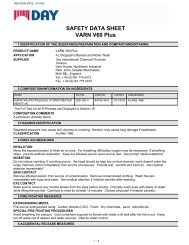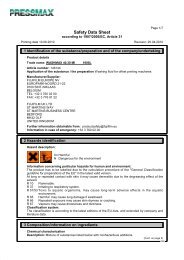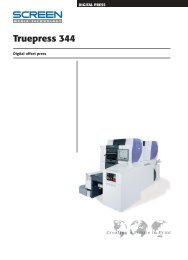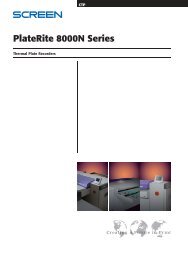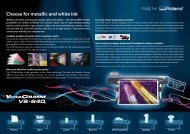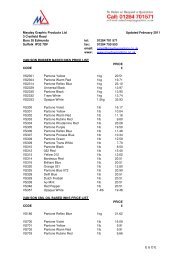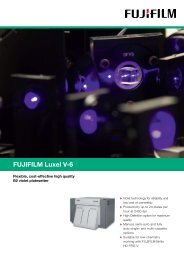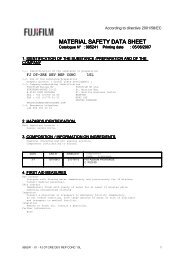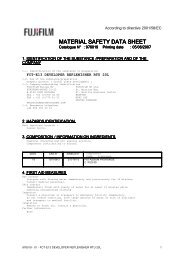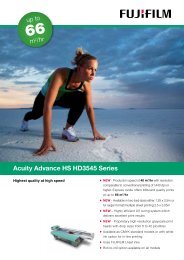SAFETY DATA SHEET - Mayday Graphic
SAFETY DATA SHEET - Mayday Graphic
SAFETY DATA SHEET - Mayday Graphic
Create successful ePaper yourself
Turn your PDF publications into a flip-book with our unique Google optimized e-Paper software.
<strong>SAFETY</strong> <strong>DATA</strong> <strong>SHEET</strong><br />
PREMIERWASH<br />
Page: 1<br />
Compilation date: 04/04/2011<br />
Revision No: 1<br />
Section 1: Identification of the substance/mixture and of the company/undertaking<br />
1.1. Product identifier<br />
Product name:<br />
Product code:<br />
PREMIERWASH<br />
C502<br />
1.2. Relevant identified uses of the substance or mixture and uses advised against<br />
1.3. Details of the supplier of the safety data sheet<br />
Company name: ECS Nottingham Ltd<br />
Unit 17<br />
Hazelford Way Industrial Estate<br />
Newstead<br />
Nottingham<br />
NG15 0DQ<br />
United Kingdom<br />
Tel: +44 (0) 1623 720 444<br />
Fax: +44 (0) 1623 720 445<br />
Email:<br />
sales@ecsnotts.co.uk<br />
1.4. Emergency telephone number<br />
Emergency tel: +44 (0) 1623 720 444<br />
Section 2: Hazards identification<br />
2.1. Classification of the substance or mixture<br />
Classification under CHIP:<br />
Classification under CLP:<br />
Most important adverse effects:<br />
-: R10; Xi: R37; N: R51/53; Xn: R65<br />
Asp. Tox. 1: H304; Flam. Liq. 3: H226<br />
Flammable. Irritating to respiratory system. Toxic to aquatic organisms, may cause long<br />
-term adverse effects in the aquatic environment. Harmful: may cause lung damage if<br />
swallowed.<br />
2.2. Label elements<br />
Label elements under CLP:<br />
Hazard statements:<br />
Signal words:<br />
Hazard pictograms:<br />
H226: Flammable liquid and vapour.<br />
H304: May be fatal if swallowed and enters airways.<br />
Danger<br />
GHS02: Flame<br />
GHS08: Health hazard<br />
[cont...]
Precautionary statements:<br />
Label elements under CHIP:<br />
Hazard symbols:<br />
<strong>SAFETY</strong> <strong>DATA</strong> <strong>SHEET</strong><br />
PREMIERWASH<br />
P243: Take precautionary measures against static discharge.<br />
P303+361+353: IF ON SKIN (or hair): Remove immediately all contaminated clothing.<br />
Rinse skin with water/shower.<br />
P280: Wear protective gloves/protective clothing/eye protection/face protection.<br />
P301+310: IF SWALLOWED: Immediately call a POISON CENTER or doctor.<br />
P331: Do NOT induce vomiting.<br />
P370+378: In case of fire: Use Alcohol or polymer foam, Carbon dioxide, Dry chemical<br />
powder for extinction.<br />
P403+235: Store in a well-ventilated place. Keep cool.<br />
Harmful.<br />
Dangerous for the environment.<br />
Page: 2<br />
Risk phrases:<br />
Safety phrases:<br />
2.3. Other hazards<br />
PBT:<br />
R10: Flammable.<br />
R37: Irritating to respiratory system.<br />
R51/53: Toxic to aquatic organisms, may cause long-term adverse effects in the aquatic<br />
environment.<br />
R65: Harmful: may cause lung damage if swallowed.<br />
S61: Avoid release to the environment. Refer to special instructions / safety data sheets.<br />
S62: If swallowed, do not induce vomiting: seek medical advice immediately and show<br />
this container or label.<br />
This substance is not identified as a PBT substance.<br />
Section 3: Composition/information on ingredients<br />
3.2. Mixtures<br />
Hazardous ingredients:<br />
LOW BOILING POINT HYDROGEN TREATED NAPHTHA - NAPHTHA (PETROLEUM), HYDRODESULPHURIZED<br />
HEAVY<br />
EINECS CAS CHIP Classification CLP Classification Percent<br />
265-185-4 64742-82-1 T: R46; Xn: R65; -: R10; N: R51/53 Carc. 1B: H350; Muta. 1B: H340; Asp.<br />
Tox. 1: H304<br />
50-70%<br />
LOW BOILING POINT NAPHTHA - UNSPECIFIED - SOLVENT NAPHTHA (PETROLEUM), LIGHT AROM.<br />
265-199-0 64742-95-6 T: R46; Xn: R65; -: R10; Xi: R37;<br />
N: R51/53<br />
Carc. 1B: H350; Muta. 1B: H340; Asp.<br />
Tox. 1: H304<br />
10-30%<br />
[cont...]
<strong>SAFETY</strong> <strong>DATA</strong> <strong>SHEET</strong><br />
PREMIERWASH<br />
Page: 3<br />
Section 4: First aid measures<br />
4.1. Description of first aid measures<br />
Skin contact:<br />
Eye contact:<br />
Ingestion:<br />
Inhalation:<br />
Remove all contaminated clothes and footwear immediately unless stuck to skin. Wash<br />
immediately with plenty of soap and water.<br />
Bathe the eye with running water for 15 minutes. Consult a doctor.<br />
Wash out mouth with water. Consult a doctor.<br />
Remove casualty from exposure ensuring one's own safety whilst doing so. Consult a<br />
doctor.<br />
4.2. Most important symptoms and effects, both acute and delayed<br />
Skin contact:<br />
Eye contact:<br />
Ingestion:<br />
Inhalation:<br />
Delayed / immediate effects:<br />
There may be irritation and redness at the site of contact.<br />
There may be irritation and redness. The eyes may water profusely.<br />
There may be soreness and redness of the mouth and throat.<br />
There may be irritation of the throat with a feeling of tightness in the chest. Exposure may<br />
cause coughing or wheezing.<br />
Immediate effects can be expected after short-term exposure.<br />
4.3. Indication of any immediate medical attention and special treatment needed<br />
Immediate / special treatment:<br />
Eye bathing equipment should be available on the premises.<br />
Section 5: Fire-fighting measures<br />
5.1. Extinguishing media<br />
Extinguishing media:<br />
Suitable extinguishing media for the surrounding fire should be used. Use water spray<br />
to cool containers.<br />
5.2. Special hazards arising from the substance or mixture<br />
Exposure hazards:<br />
In combustion emits toxic fumes.<br />
5.3. Advice for fire-fighters<br />
Advice for fire-fighters:<br />
Wear self-contained breathing apparatus. Wear protective clothing to prevent contact<br />
with skin and eyes.<br />
Section 6: Accidental release measures<br />
6.1. Personal precautions, protective equipment and emergency procedures<br />
Personal precautions:<br />
Refer to section 8 of SDS for personal protection details. If outside do not approach from<br />
downwind. If outside keep bystanders upwind and away from danger point. Mark out the<br />
contaminated area with signs and prevent access to unauthorised personnel. Turn<br />
leaking containers leak-side up to prevent the escape of liquid.<br />
6.2. Environmental precautions<br />
Environmental precautions:<br />
Do not discharge into drains or rivers. Contain the spillage using bunding.<br />
[cont...]
<strong>SAFETY</strong> <strong>DATA</strong> <strong>SHEET</strong><br />
PREMIERWASH<br />
Page: 4<br />
6.3. Methods and material for containment and cleaning up<br />
Clean-up procedures:<br />
Absorb into dry earth or sand. Transfer to a closable, labelled salvage container for<br />
disposal by an appropriate method.<br />
6.4. Reference to other sections<br />
Reference to other sections:<br />
Refer to section 8 of SDS.<br />
Section 7: Handling and storage<br />
7.1. Precautions for safe handling<br />
Handling requirements:<br />
Avoid direct contact with the substance. Ensure there is sufficient ventilation of the area.<br />
Do not handle in a confined space. Avoid the formation or spread of mists in the air.<br />
7.2. Conditions for safe storage, including any incompatibilities<br />
Storage conditions:<br />
Store in cool, well ventilated area. Keep container tightly closed. The floor of the storage<br />
room must be impermeable to prevent the escape of liquids.<br />
7.3. Specific end use(s)<br />
Specific end use(s):<br />
No data available.<br />
Section 8: Exposure controls/personal protection<br />
8.1. Control parameters<br />
Workplace exposure limits:<br />
Not applicable.<br />
8.2. Exposure controls<br />
Engineering measures:<br />
Respiratory protection:<br />
Hand protection:<br />
Eye protection:<br />
Skin protection:<br />
Ensure there is sufficient ventilation of the area. The floor of the storage room must be<br />
impermeable to prevent the escape of liquids.<br />
Self-contained breathing apparatus must be available in case of emergency.<br />
Protective gloves.<br />
Safety glasses. Ensure eye bath is to hand.<br />
Protective clothing.<br />
Section 9: Physical and chemical properties<br />
9.1. Information on basic physical and chemical properties<br />
State: Liquid<br />
Viscosity: Non-viscous<br />
Flash point°C: ~41C<br />
9.2. Other information<br />
Section 10: Stability and reactivity<br />
10.1. Reactivity<br />
Reactivity:<br />
Stable under recommended transport or storage conditions.<br />
[cont...]
<strong>SAFETY</strong> <strong>DATA</strong> <strong>SHEET</strong><br />
PREMIERWASH<br />
Page: 5<br />
10.2. Chemical stability<br />
Chemical stability:<br />
Stable under normal conditions.<br />
10.3. Possibility of hazardous reactions<br />
Hazardous reactions:<br />
Hazardous reactions will not occur under normal transport or storage conditions.<br />
Decomposition may occur on exposure to conditions or materials listed below.<br />
10.4. Conditions to avoid<br />
Conditions to avoid:<br />
Heat.<br />
10.5. Incompatible materials<br />
Materials to avoid:<br />
Strong oxidising agents. Strong acids.<br />
10.6. Hazardous decomposition products<br />
Haz. decomp. products:<br />
In combustion emits toxic fumes.<br />
Section 11: Toxicological information<br />
11.1. Information on toxicological effects<br />
Relevant effects for mixture:<br />
Effect Route Basis<br />
Irritation INH Hazardous: calculated<br />
Symptoms / routes of exposure<br />
Skin contact:<br />
Eye contact:<br />
Ingestion:<br />
Inhalation:<br />
Delayed / immediate effects:<br />
There may be irritation and redness at the site of contact.<br />
There may be irritation and redness. The eyes may water profusely.<br />
There may be soreness and redness of the mouth and throat.<br />
There may be irritation of the throat with a feeling of tightness in the chest. Exposure may<br />
cause coughing or wheezing.<br />
Immediate effects can be expected after short-term exposure.<br />
Section 12: Ecological information<br />
12.1. Toxicity<br />
12.2. Persistence and degradability<br />
Persistence and degradability:<br />
Not biodegradable.<br />
12.3. Bioaccumulative potential<br />
Bioaccumulative potential:<br />
Bioaccumulation potential.<br />
12.4. Mobility in soil<br />
Mobility:<br />
Readily absorbed into soil.<br />
[cont...]
<strong>SAFETY</strong> <strong>DATA</strong> <strong>SHEET</strong><br />
PREMIERWASH<br />
Page: 6<br />
12.5. Results of PBT and vPvB assessment<br />
PBT identification:<br />
This substance is not identified as a PBT substance.<br />
12.6. Other adverse effects<br />
Other adverse effects:<br />
Toxic to aquatic organisms. Toxic to soil organisms.<br />
Section 13: Disposal considerations<br />
13.1. Waste treatment methods<br />
Disposal operations:<br />
NB:<br />
Transfer to a suitable container and arrange for collection by specialised disposal<br />
company.<br />
The user's attention is drawn to the possible existence of regional or national<br />
regulations regarding disposal.<br />
Section 14: Transport information<br />
14.1. UN number<br />
UN number:<br />
UN1268<br />
14.2. UN proper shipping name<br />
Shipping name:<br />
PETROLEUM DISTILLATES, N.O.S.<br />
14.3. Transport hazard class(es)<br />
14.4. Packing group<br />
Transport class: 3<br />
Packing group:<br />
III<br />
14.5. Environmental hazards<br />
Environmentally hazardous: Yes Marine pollutant: No<br />
14.6. Special precautions for user<br />
Special precautions: No special precautions.<br />
Tunnel code: D/E<br />
Transport category: 3<br />
Section 15: Regulatory information<br />
15.1. Safety, health and environmental regulations/legislation specific for the substance or mixture<br />
15.2. Chemical Safety Assessment<br />
Chemical safety assessment:<br />
A chemical safety assessment has not been carried out for the substance or the mixture<br />
by the supplier.<br />
Section 16: Other information<br />
[cont...]
<strong>SAFETY</strong> <strong>DATA</strong> <strong>SHEET</strong><br />
PREMIERWASH<br />
Page: 7<br />
Other information<br />
Other information:<br />
Phrases used in s.2 and 3:<br />
Legal disclaimer:<br />
This safety data sheet is prepared in accordance with Commission Regulation (EU) No<br />
453/2010.<br />
* indicates text in the SDS which has changed since the last revision.<br />
H226: Flammable liquid and vapour.<br />
H304: May be fatal if swallowed and enters airways.<br />
H340: May cause genetic defects .<br />
H350: May cause cancer .<br />
R10: Flammable.<br />
R37: Irritating to respiratory system.<br />
R46: May cause heritable genetic damage.<br />
R51/53: Toxic to aquatic organisms, may cause long-term adverse effects in the aquatic<br />
environment.<br />
R65: Harmful: may cause lung damage if swallowed.<br />
The above information is believed to be correct but does not purport to be all inclusive<br />
and shall be used only as a guide. This company shall not be held liable for any<br />
damage resulting from handling or from contact with the above product.<br />
[final page]




